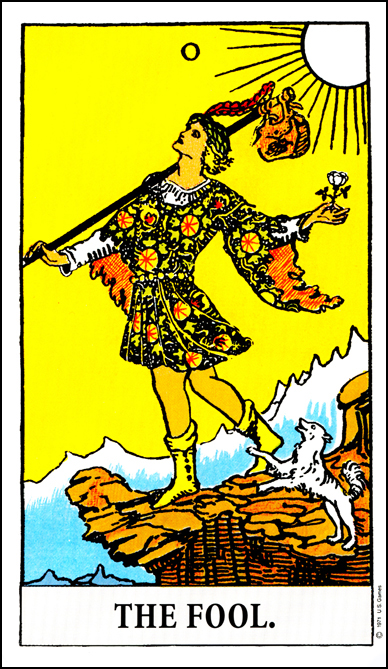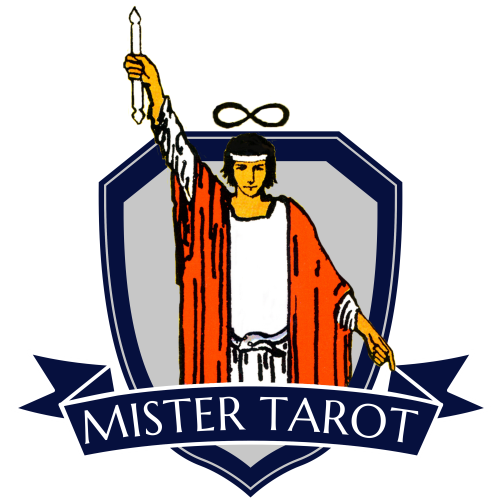He’s gone from zero to hero in 450 years. In one of the oldest Tarot decks (Visconti-Sforza Tarocchi) The Fool of the Tarot was a homeless beggar, stumbling around village streets in a daze. He had feathers in his hair and he was clothed in filthy rags. He represented the lowest person in society. Now, of course, he’s one of the most popular cards in the whole deck.
Back in the 15th century, in the Mantegna Tarocchi, this image was known as il Misero, which means ‘the beggar’. In the Steele Manuscript (a sermon written by a Franciscan monk) it was listed as El matto sine nulla (nisi velint), which can be roughly translated as ‘the fool with nothing’. Both represent a person trapped in the lowest of human conditions. It was a life without money, skills or education. Fools and beggars were a common sight in Renaissance Italy where Tarot cards were created.
 Images of fools were common in Medieval art. The image shown on the left is Giotto’s fresco of Foolishness (one of the seven vices) displayed in the Arena Chapel in Padua, Italy (1306). Like the Visconti-Sforza card, this fool was barelegged, wore simple clothing, had feathers in his hair, and carried a staff or club.
Images of fools were common in Medieval art. The image shown on the left is Giotto’s fresco of Foolishness (one of the seven vices) displayed in the Arena Chapel in Padua, Italy (1306). Like the Visconti-Sforza card, this fool was barelegged, wore simple clothing, had feathers in his hair, and carried a staff or club.
Over the years various symbols in the design were changed. In the Marseilles Tarot, The Fool’s image was of a traveler carrying his bag on a stick with an animal leaping at his legs — usually this was a dog, but sometimes it was a cat. At one time a crocodile was shown with the Fool!
In the late 1800s The Golden Dawn described this card as ‘The Foolish Man’, but they also included qualities such as ‘spirituality’. From that point in time, The Fool was endowed with an aura of ‘the holy fool’, a form of Divine Madness.
In 1909 when A. E. Waite asked Pamela Coleman Smith to draw images for his Tarot deck, he based the design upon the Marseilles Tarot, but he introduced many new elements into the card called The Fool, such as the edge of the cliff, and the sun lighting the way.
A. E. Waite’s new description was, “He is a prince of the other world on his travels through this one — all amidst the morning glory, in the keen air. The sun, which shines behind him, knows whence he came, whither he is going, and how he will return by another path after many days. He is the spirit in search of experience.”
 The image of the modern Fool is one of innocence and simplicity. He represents a person with pure intentions — especially the individual who has awakened to their spiritual purpose and who is embarking upon the quest for higher knowledge. He is a blend of the inner child and the wise old man. He is a free spirit, a wanderer, one who has childlike perspective. The Fool’s expectations are yet to be formed and he is simply living in the moment.
The image of the modern Fool is one of innocence and simplicity. He represents a person with pure intentions — especially the individual who has awakened to their spiritual purpose and who is embarking upon the quest for higher knowledge. He is a blend of the inner child and the wise old man. He is a free spirit, a wanderer, one who has childlike perspective. The Fool’s expectations are yet to be formed and he is simply living in the moment.
“The Fool’s Journey” is the name of the sequence of experiences The Fool encounters as he travels through the physical world. It’s the adventure of life itself, as revealed through the teachings of all the characters in the Major Arcana.
The Fool has become the hero of the Tarot cards. He becomes ‘enlightened’ as he gathers experience and insight into his own nature and the nature of the world around him. As he wanders through life, he eventually discovers his own the wisdom. He also represents us, so it’s no wonder we cheer him on as he fulfils his sacred quest!
